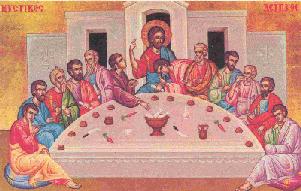Christian Ideas of Sacrifice
| sacrifice: from Latin sacrificare; sacer sacred, holy + facere to make. 1. To make an offering of; to consecrate or present to a divinity by way of expiation or propitiation, or as a token acknowledgment or thanksgiving; to immolate on the altar of God, in order to atone for sin, to procure favor, or to express thankfulness; 2. Hence, to destroy, surrender, or suffer to be lost, for the sake of obtaining something; to give up in favor of a higher or more imperative object or duty; to devote, with loss or suffering. 3. To destroy; to kill. 4. To sell at a price less than the cost or actual value. Webster's Revised Unabridged Dictionary, 1996 |
 |
| Christ on the Cross, by El Greco Cathedral of San Juan at Toledo |
|
What do Blood, Power, Gender, and Authority have to do with sacrifice?
|
The importance of bloodshed in sacrifice did not originate in the Christian tradition. Sacrifice was a major part of the ancient world. The ideas of sacrifice as an atonemnt found in the Hebrew Bible (Old Testament) form much of the basis for Christian conceptions of sacrifice. In the Old Testament, the God-given means of expiation was the sacrificial blood (Young 27-28). The idea of a dying God whose sacrifice results in eternal life for followers is also found in Roman mystery religions.
In its early years, Christianity struggled to distinguish itself from Judaism and mystery cults as the Ďcorrectí
religion. Although they took many ideas from these traditions, Christians developed a unique sacrificial tradition.
The idea of sacrifice as a spiritual, self-directed act instead of the offering of animals was one such distinction.
The body itself, with its links to the body of Christ, remained very important to Christians. Their forms of sacrifice
focused on the bodies of its members as a living sacrifice.
The Sacrifice of Jesus
Christians understand Christ's death on the cross to be a necessary atonement for the sins of humankind. In the
first generation after Jesus' death, the apostle Paul wrote: For I delivered to
you first of all, what I also received, that Christ died for our sins according to the scriptures, and that he
was buried, and that he rose again on the third day. . . I Corinthians 15: 3-4. Christ 's death
was the final sacrifice, which superseded the need for animal sacrifices offered in the past by the high priest: Having therefore a great high priest who has passed into the heavens, Jesus Son of God.
. . because he continues forever, he has an everlasting priesthood. (Hebrews 4:
14, 7:24). Christ was both priest and sacrificial victim.
Christianity often refers to Jesusí Passion as the "ultimate" or "perfect" sacrifice. The Christian church believed that Christís death occurred as the ultimate expiation of sins and that it annulled the need for sacrifices named by the Old Testament. Christians turned from the notion of animal sacrifice to self-sacrifice. The methods by which Christians presented themselves as purified of sin, then, could be understood as a form of sacrifice. Baptism, the Lords Supper (the Eucharist), and martyrdom are major traditions of Christian sacrifice. All of these acts are necessary for redemption. Using Jesus as an exemplar, Christians believed that one could only gain redemption through sacrifice. These beliefs and traditions illustrate the importance of blood in Christian spiritual cleansing.
The Sacrifice of Martyrdom
This idea of a living sacrifice was bound to the Christian tradition by blood. Baptism and martyrdom were efforts to cleanse and redeem oneself from earthly, mortal evil. When a person was baptized, he or she confessed his/her belief in Jesus as the Christ thereby admitting that Christís blood, shed on the cross, was Jesusí self-sacrifice for the forgiveness of all sins. The proclamation of this belief in the "perfect sacrifice" provided one with redemption. Martyrdom also was a very important form of Christian sacrifice. Due to the magnitude of this topic we have devoted an entire portion of our site to the topic of martyrdom.
The imitation of Christ (Imitatio Christi) has been a goal of Christians in every age but its meaning has been imagined in forms as diverse as monasticism, liberation theology, and the contemporary Christian slogan WWJD (What Would Jesus Do?). A few unusual Christians have even experienced such an identification with Christ that they have manifested Christ's wounds (stigmata) upon their own bodies.
According to the Encyclopedia Britannica Online baptism is a sacrament of admission to the Christian Church. The forms and rituals of the various churches vary, but Baptism almost invariably involves the use of water and the Trinitarian invocation, "I baptize you: In the name of the Father, and of the Son, and of he Holy Spirit." The candidate may be wholly or partly immersed in water, the water may be poured over the head, or a few drops may be sprinkled or placed on the head.
Baptism is preformed to expiate the sins of a human through a ritual cleansing of the soul. It must be performed by a priest or memember of the clergy (depending upon the denomination being described). Baptism has been imagined as a sacrificial death to sin and symbolic rebirth as a member of the Christian church.
| Probably the best known of the Christian sacrifices today is sacrifice of communion. The spaces in which Jesus' sacrificial death is symbolically re-enacted are sites of immense spiritual power. Altars were imagined as sacrificial places from very early times, and it became common to place martyrs' relics either under or in them. |  |
|
| The historical development of the Eucharist as a sacrificial meal that symbolically re-creates Christ's sacrificial death at every occasion, everywhere in the world, provided a way for sacrifice to become a central part of Christian worship. In this way Christians are able to share "in the benefits of his [Jesusí] redemptive death." (Young 63). Like martyrdom, this is such an expansive topic that another link on the site deals solely with the practice of the Eucharist. | The elements of the Eucharist: wine representing the blood and bread representing the body of
Christ.
|
| Priests and pastors are commonly imagined as church leaders who especially model the imitation of Jesus' way of life. Priests are the only Catholic Christians authorized to perform the sacrifice of the Mass (the Eucharist) and most of the sacraments. The Catholic Church has insisted that priests must be male because Jesus was. Thus, the imitation of Jesus' life has gendered implications. Although women can become pastors in most Protestant denominations, Protestant women have also considered the extent to which Jesus' gender limits women's ability to truly imitate Jesus' life. Because Jesus is believed to be not only human but divine, does his human gender mean that divinity can only be imagined as masculine? |  |
The spaces in which Jesus' sacrificial death is symbolically re-enacted are sites of immense spiritual power. Altars were imagined as sacrificial places from very early times, and it became common to place martyrs' relics either under or in them. In the Middle Ages nuns were not allowed to enter the inner sanctuary area of their own convent churches (where the Eucharist was performed), not even to clean it. Although Catholic women are excluded from the performance of this ritual, this is not the only Catholic site of power. Women are not excluded from the cult of saints, nor are they excluded from pilgrimages to saints' and martyrs' shrines. In fact, both women and men, both in the past and today, have experienced visionary rapture, weeping, and miraculous interventions at shrine sites.
The cult of saints and martyrs is not part of Protestant Christianity, but the super-emphasis upon the Bible as a site of sacrality provides further access to sites of Christian spiritual power. The Protestant emphasis upon the "priesthood of all believers" historically has meant that all Christians are considered to have equal access to the sacred scriptures. Catholic Christianity has generally limited interpretation of Scripture, like performance of the Mass, to priests and authorized teachers.
So, as far as the New Testament is concerned, the sacrificial blood of Christ is expiatory, by the sacrifices of the Old Testament, which are fulfilled and annulled by his greater and more efficacious sacrifice (Young 72). However it is the Judaic idea of blood as a purification of sin that is the main artery of Christian sacrifice. For it was the blood Christ shed, his death, that provided Christians with redemption from sin. Christian sacrifice serves to mirror and celebrate in the ultimate sacrifice of Jesus which provides believers with redemption.
Brown, Peter. The Body and Society: Men, Women, and Sexual Renunciation in Early Christianity (New York: Columbia University Press, 1988).
Encyclopedia Britannica Online
Ehrenreich, Barbara. Blood Rites. ( 1998).
Frankiel, Sandra. Christianity (San Francisco: Harper Collins, 1985).
Rubin, Miri. Corpus Christi: The Eucharist in Late Medieval Culture (Cambridge: Cambridge University Press, 1991).
Stevens, Marianne, ed. Reconstructing the Christ Symbol: Essays in Feminist Christology (New York: Paulist Press, 1993).
Young, Frances M. Sacrifice and the Death of Christ. (SPCK: London, 1975).